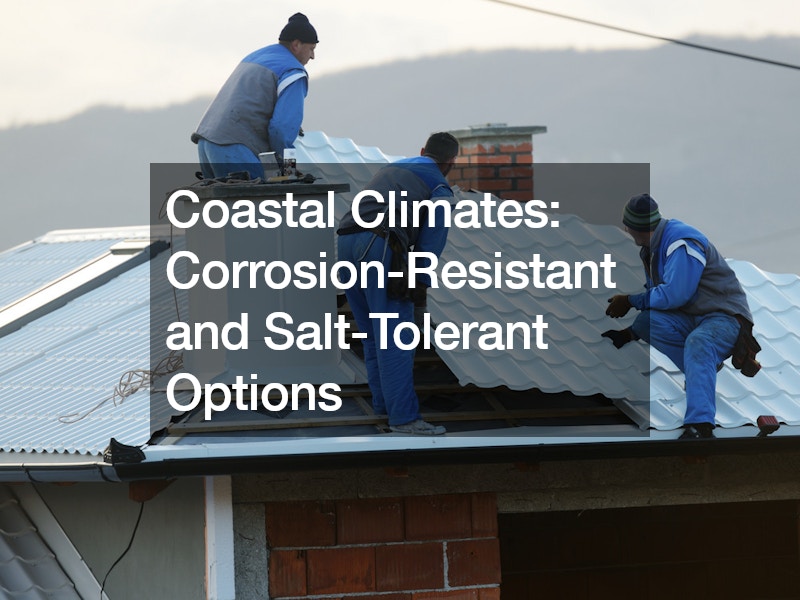A house’s roof is one of its most crucial parts, offering protection from the elements and contributing significantly to its overall aesthetic. Choosing the right roofing material and design is a decision that requires careful consideration, especially when factoring in climate conditions. Permanent roofing solutions are becoming increasingly popular due to their longevity and low maintenance needs. This comprehensive guide will walk you through the various climate considerations for roofing and help you make informed decisions whether you are dealing with hot, cold, rainy, windy, or coastal climates. By thoroughly understanding your local climate, building codes, and roof material options, you can ensure your residential roofing project is a long-term success.
Understanding Your Local Climate

Understanding your local climate is fundamental when it comes to permanent roofing. Different regions experience varying weather patterns that can impact the effectiveness and longevity of your roof. For instance, roofing companies in arid regions may recommend materials that reflect sunlight, while those in snowy areas might focus on insulation and snow load-bearing capabilities. Knowing your climate’s quirks will help you narrow down the best roofing options for your home.
Local roofing companies are valuable resources for understanding how different materials perform under specific climatic conditions. Their expertise can guide you toward a roof that suits your aesthetic preferences and functional needs. Roofing solutions come in various forms, such as metal, tile, and shingles, each offering unique benefits depending on the climate.
Roofing solutions are designed to last several decades with proper maintenance. However, this longevity can be compromised if the material is not suited to your local climate. Therefore, it is crucial to consider your area’s specific conditions to make an informed decision. Consulting with local roofing companies can furnish you with the insights needed to make a reliable and durable choice. Understanding these factors ensures your roof performs optimally and lasts for years to come.
Researching Local Building Codes and Regulations
Before proceeding with any roofing project, it is essential to familiarize yourself with local building codes and regulations. These codes are put in place to ensure safety, structural integrity, and compliance with energy efficiency standards. For residential roofing projects, understanding these regulations can save you from future headaches and potential fines.
Building code requirements often vary from region to region, particularly for areas with unique climate conditions. For example, regions prone to high winds or heavy snowfall may have stricter codes for roof installation to ensure durability and safety. Permanent roofing solutions must meet these codes to be viable long-term options.
Involving a professional roofer early in the planning stages can help you navigate through these regulatory waters. They are generally well-versed in local codes and can provide valuable advice on materials and techniques that not only meet but exceed standard requirements. This can also offer you peace of mind, knowing that your roofing installation complies with all necessary regulations. Consulting with local professionals ensures your project aligns with legal standards, guaranteeing a safe and durable roofing solution for your home.
Hot Climates: Choosing Reflective and Heat-Resistant Materials
Hot climates present unique challenges for roofing, primarily concerning heat absorption and energy efficiency. Permanent roofing materials designed for these conditions often feature reflective surfaces that deflect sunlight, thereby reducing heat absorption. Local roofers generally recommend materials like metal or light-colored tiles, effectively keeping homes cool.
Reflective and heat-resistant materials are not only beneficial for comfort but also for energy savings. By reducing the amount of heat that penetrates your home, you can significantly cut down on air conditioning costs. Local roofing companies often have a range of options tailored for hot climates to ensure your roofing solution is both functional and cost-efficient.
Furthermore, hot climates can accelerate wear and tear on roofing materials. Therefore, it is crucial to opt for roofing that can withstand high temperatures over time. Materials like metal and concrete tiles are durable and effective for these conditions, ensuring your investment stands the test of time. Consulting with local roofers can help you identify the best options for heat-resistant materials that will enhance your comfort and savings in the long run.
Cold Climates: Insulation and Snow Load Considerations

Cold climates pose different challenges, such as the need for effective insulation and the ability to handle heavy snow loads. Permanent roofing materials suitable for cold climates are often designed to provide excellent thermal insulation, helping to keep homes warm. Roof installation in these areas typically involves additional layers to enhance insulation and energy efficiency.
Snow load considerations are another critical aspect. In regions prone to heavy snowfall, the roofing material and design must be capable of supporting significant weight without compromising structural integrity. Roofing contractors often recommend materials like asphalt shingles or metal, which offer both durability and effective insulation.
Additionally, proper roof installation techniques are essential to prevent ice dams and water infiltration. Professional roofers have the expertise to install roofing solutions that can withstand the demands of harsh winter conditions. By selecting the right materials and ensuring proper installation, you can effectively protect your home from the challenges of cold climates and ensure long-lasting performance.
Rainy Climates: Waterproofing and Drainage Solutions
In regions with frequent rainfall, waterproofing and effective drainage are paramount. Permanent roofing materials suitable for rainy climates often include features like waterproof coatings and interlocking designs to prevent water infiltration. Roofing contractors recommend materials such as asphalt shingles and metal roofs, which are known for their water-resistant properties.
Effective drainage is equally important to prevent water from pooling on the roof, which can lead to leaks and structural damage. A well-designed drainage system ensures that rainwater is efficiently directed away from your home, protecting both the roof and the underlying structure. Working with a local roofing company can help you design a drainage system that complements your roofing solution and enhances overall home protection.
Regular roofing maintenance is crucial in rainy climates to ensure that waterproofing and drainage systems remain effective. Professional roofers can perform inspections and repairs as needed, prolonging the life of your roof. By investing in roofing solutions that prioritize waterproofing and drainage, you can ensure long-term protection, durability, and peace of mind for your home.
Windy Climates: Impact-Resistant Roofing Materials
Windy climates require roofing materials that can withstand strong gusts and potential debris impacts. Permanent roofing options such as metal and high-quality asphalt shingles are often recommended for their durability and resistance to wind damage. Local roofers can provide insights into materials that have been tested and proven effective in windy conditions.
Impact-resistant materials are essential in windy climates to prevent damage from flying debris. These materials often undergo rigorous testing to ensure they can withstand impacts without compromising the roof’s integrity. Roofing companies knowledgeable about windy climates can guide you in selecting materials that offer the best protection against wind-driven debris and storms.
Proper roof installation techniques are crucial for ensuring that the roofing materials remain secure during high winds. Professional roofers have the expertise to install roofing solutions that meet the demands of windy climates. By choosing impact-resistant materials and ensuring correct installation, you can effectively protect your home from the challenges posed by strong winds and maintain your roof’s durability over time.
Coastal Climates: Corrosion-Resistant and Salt-Tolerant Options

Coastal climates present unique challenges due to the presence of salt and moisture in the air, which can accelerate corrosion and material degradation. Permanent roofing materials suitable for these conditions are often designed to be corrosion-resistant and salt-tolerant. Roofing companies with experience in coastal areas can recommend materials such as metal with protective coatings or specialized concrete tiles.
Salt tolerance is crucial to prevent the damaging effects of salt on the roofing material, which can lead to premature aging and failure. Materials like stainless steel and certain types of treated wood are known for their salt-resistant properties. Partnering with a roof replacement service that understands coastal challenges can help you select materials that offer long-term durability and resist corrosion effectively.
Regular roofing maintenance is essential in coastal climates to prevent the accumulation of salt and moisture, which can accelerate wear and tear. Professional roofers can perform inspections and apply protective treatments as needed. By investing in roofing solutions that prioritize corrosion resistance and salt tolerance, you can ensure your roof remains robust, reliable, and capable of withstanding coastal environmental conditions.
Urban vs. Rural Climates: Noise Reduction and Environmental Factors
Urban and rural climates present different challenges and considerations for roofing. In urban areas, noise reduction and environmental factors are often significant considerations. Permanent roofing materials with noise-dampening properties, such as asphalt shingles or composite tiles, can help create a quieter indoor environment. Roofing maintenance is crucial to ensure these materials continue to perform effectively over time and provide ongoing noise reduction benefits.
Environmental considerations, such as pollution and heat island effects, can also impact roofing choices in urban areas. Materials that reflect sunlight and resist pollution buildup are often recommended to mitigate these effects. Partnering with a local roofing company familiar with urban challenges can help you select materials that address these specific needs and optimize environmental performance.
In rural areas, considerations may include resistance to natural elements such as fire and pests. Roofing options like metal and clay tiles offer excellent resistance to these threats. By understanding the unique challenges of urban and rural climates and selecting appropriate materials, you can ensure your roofing solution meets the demands of your specific environment effectively and provides long-lasting protection for your home.
Evaluating Long-Term Costs and ROI
When choosing a permanent roofing solution, evaluating long-term costs and return on investment (ROI) is essential. While the initial cost of roofing materials may be higher, their durability and low maintenance requirements often result in cost savings over time. Professional roofers can provide estimates for both short-term and long-term costs to help you make an informed decision and plan your budget effectively.
Long-term durability is a significant factor in calculating ROI. Roofing materials are designed to last several decades, reducing the need for frequent repairs and replacements. Roofing services that offer warranties and guarantees can provide additional peace of mind and enhance the overall value of your investment in roofing materials that improve your home.
Energy efficiency is another critical factor in evaluating long-term costs. Roofing materials that enhance insulation and reflect sunlight can lead to significant energy savings. Consulting with a professional roofer can help you select materials that offer the best balance of initial cost, long-term durability, and energy efficiency, maximizing your ROI and providing substantial savings over time.
Hiring a Professional Roofer

Hiring a professional roofer is a crucial step in any roofing project. Experienced roofing services can provide expert advice on material selection, installation techniques, and maintenance. Their expertise ensures that your permanent roofing solution is installed correctly and meets all necessary standards for safety and performance.
When selecting a roofing contractor, it is essential to consider their experience, reputation, and certifications. A reputable roofing company can provide references and examples of previous work, giving you confidence in their ability to deliver a high-quality result. Professional roofers often offer warranties on their work, providing additional security and peace of mind for your investment in a long-lasting roofing solution.
By partnering with professional roofing services, you can ensure that your roofing solution is tailored to your specific needs and climate conditions. Their expertise and commitment to quality craftsmanship can help you achieve a durable, aesthetically pleasing, and cost-effective roofing solution that enhances the value and protection of your home.
Choosing the right roofing solution for your home requires careful consideration of various factors, including local climate, building codes, material properties, and long-term costs. Understanding the unique challenges of your climate and selecting materials designed to address those challenges can ensure long-lasting performance and protection. Partnering with professional roofers and utilizing their expertise can help you navigate through the complexities of material selection, installation, and maintenance. By investing in a permanent roofing solution tailored to your specific needs, you can achieve a beautiful, durable, and cost-effective roof that stands the test of time.


